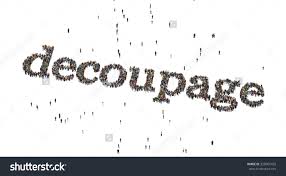 by Kierston Drier
by Kierston Drier
What exactly is Decoupage, or, further, Decoupage Technique? How is it different from Montage? In colloquial English the word Decoupage has been used less frequently, and Montage has come to refer to its basic concept. Montage, Decoupage and Decoupage technique, however, are different things.
Decoupage, translated from French, means “to cut up”. To fully understand its meaning though, we must first take a brief look concepts surrounding Montage. Montage translates as “assembly”, and in film refers to the specific choices made in placing one shot directly next to another to create a desired effect. A montage refers to an arrangement of visuals constructed to create a specific emotional effect and produce a certain emotional response. A Decoupage, is slightly harder to pin down. At its origin, in French, Decoupage indicates that the set of images captured are to be edited together to help convey the story’s narrative, and in English, it is often simply considered editing. The term also indicates that the images that are being assembled together will convey the movement of the storyline, even if the scenes being cut together are scenes taking place with physical spacial difference. Decoupage technique is roughly defined as translating a narrative script into a detailed outline of visuals for a camera to capture, and the process of editing within those images. Confused? I was too.
Confusion on the terms appears to have stemmed from a multitude of factors, including the translation and interpretation of the words from one language to another. For the purpose of this column though, we will use an example and interpreted it through all three terms. Our example will be the narrative tale of a couple that find themselves in danger of falling while walking on an old bridge.
A Montage of this would refer to a cut of images, presented in a way that elicits an emotional response. In our example- a close up shot of our couple walking on an old bridge, followed by a shot of a bridge beam fracturing. This will create the illusion that the couple could be in immediate danger. A host of emotional responses can be felt by the audience, simply by placing these two visuals next to each other.
Decoupage Technique, using the same example, is the process of reading the script, understanding the conflict will be the couple escaping a collapsing bridge, and breaking down that narrative into a series of visuals that will convey the story.
And;
Decoupage (for an English reader) would be an editing term that umbrellas the aforementioned terms together; it would signify the physical act of cutting the images together, while also understanding the emotional and cinematic story being told through those visuals.
Decoupage, therefore, indicates a highly nuanced and collaborative construct, that encompasses editing, narrative storytelling, camera functions and often includes the use of montage.
In short, Decoupage “cuts up” the script and establishes that scripts’ visuals, and Montage “assembles” them into an emotional story.
The breakdown of the language and terminology may at first glance seem dry, but the subtle and significant differences between the words fascinate this column writer ( and, as a side note, make me very boring at parties…unless they are film related ones!)
REFERENCES AND RESOURCES
Montage and Decoupage Research Questions by Axel Debenhamledon (article dated April 24th 2015) Mediafactory.org
Montage, Decoupage, Mise en Scene; Essays on Film form by Laurent le Forestier, Timothy Barnard, frank Kessler
Reel Rundown: How To Talk Like A Film Critic; Glossary, by Jane Bovary, April 20 2016
Reblogged this on WILDsound Writing and Film Festival Review.
LikeLike
Reblogged this on WILDsound Writing and Film Festival Review.
LikeLike